Intel 3160NGU Wireless Network Adapter User Manual 2
Intel Mobile Communications Wireless Network Adapter 2
Intel >
Contents
- 1. User Manual
- 2. User Manual 1
- 3. User Manual 2
User Manual 2
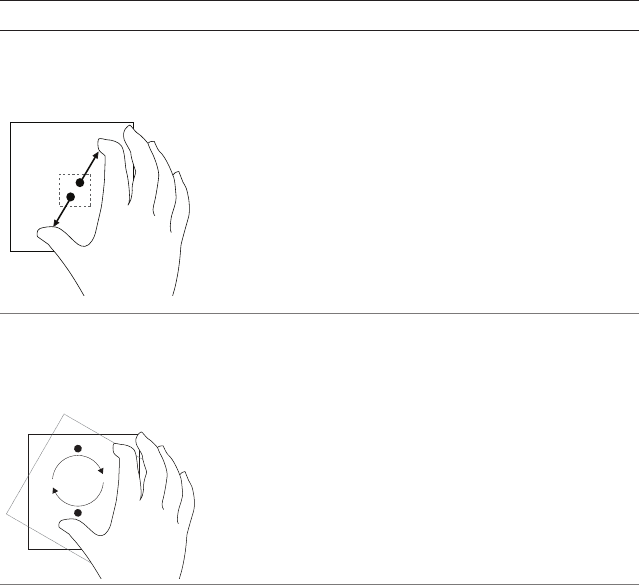
24 │ Using Your Computer
Finger gestures Allows you to:
Zoom in
Touch the display with two fingers
and then move the fingers apart.
Increase the zoom level of an image
or web page.
Rotate
Touch the display with two or more
fingers and then move the fingers in a
clockwise or counter-clockwise arc.
Rotate an object by 90 degrees.
For more information on using Windows 8 Start screen, see
http://support.dell.com/windows8 and
http://windows.microsoft.com/en-US/windows-8/get-started as
well as touching the Dell Getting Started with Windows application (on
the Metro screen).
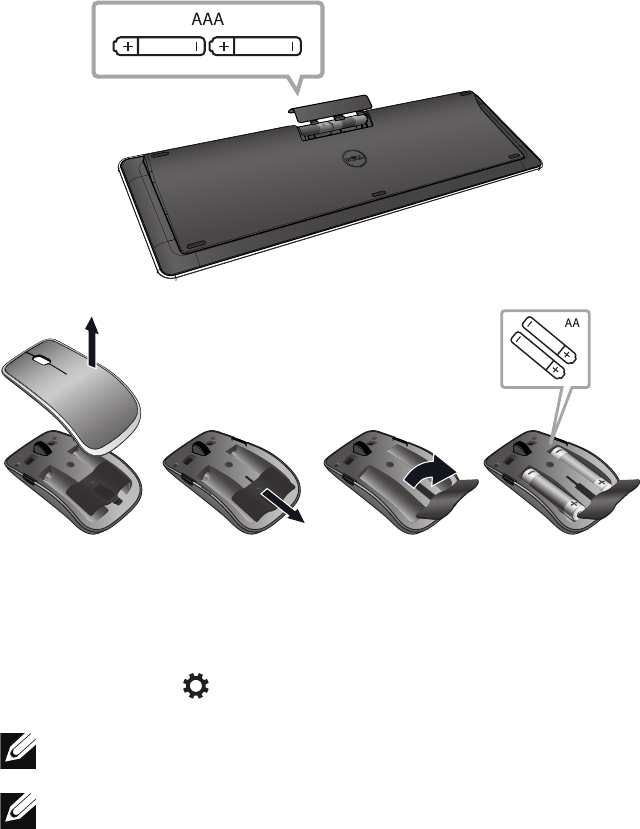
Using Your Computer │ 2 5
Using the Keyboard and Mouse
If you purchased a wireless keyboard and mouse with your computer,
they will be already paired. To use the keyboard and mouse, make sure
both devices have batteries installed and are powered on.
Pairing the wireless keyboard and mouse
If the keyboard and mouse do not work automatically you may need to
add them manually:
Swipe from the right edge of the display to access Charms.1
Touch 2 Settings → Change PC Settings→ Devices→ Add a
device, to manually add a keyboard and mouse.
NOTE: If the keyboard or mouse pairing has been lost for some reason,
use these steps to pair them again.
NOTE: The wireless keyboard and mouse may ship with a USB dongle.
You do not need to install the dongle to use the wireless keyboard and
mouse on this computer.
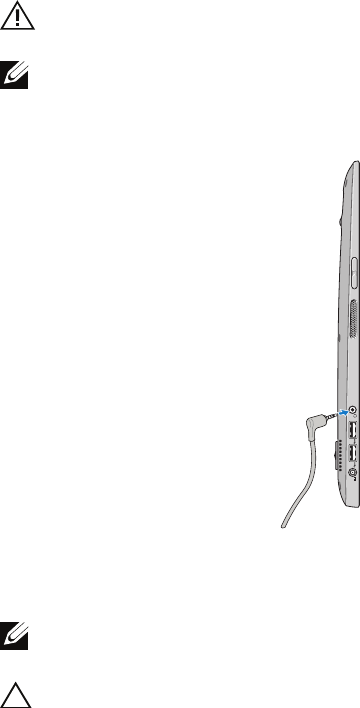
26 │ Using Your Computer
Using Headphones/Microphones
Your computer has a headphone/microphone combo port that
supports a headphone, a microphone, or a combo device to listen to
music, record audio, or make voice calls.
WARNING: Listening to loud music for extended periods of time can
lead to hearing loss.
NOTE: It is recommended to keep the volume level low before
connecting the headphones to your computer.
Connect headphones to the audio port.1
Insert the headphones in your ears and adjust the volume level to 2
a comfortable level.
NOTE: The integrated speakers on your computer are muted
automatically when you connect an audio device to the audio port.
CAUTION: To prevent damage to the headphones when disconnecting
them from your computer, pull the connector and not the cable.
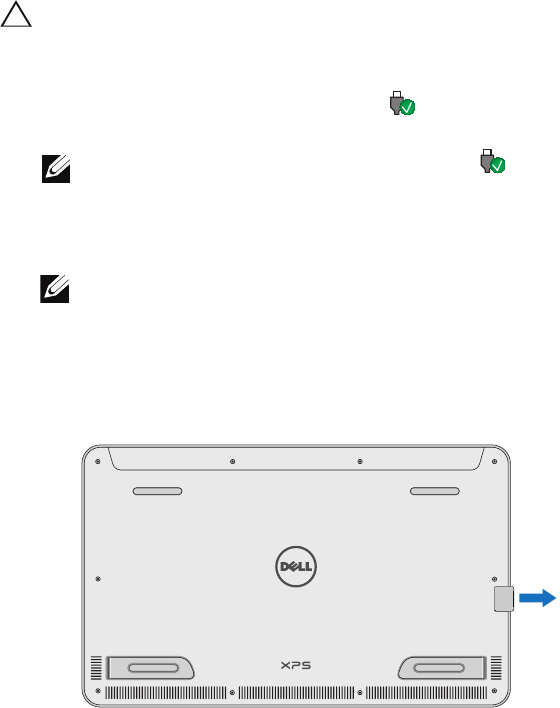
Using Your Computer │ 2 7
Removing the SD Card
CAUTION: To avoid data loss, ensure all read/write operations to the
SD card are complete before removing it from the computer.
Touch the bottom left corner to enter Desktop mode. 1
Touch/click 2 Safely Remove Hardware in the notification area
at the bottom-right corner of the screen.
NOTE: If you don’t see Safely Remove Hardware , touch Show
Hidden Icons to display all icons in the notification area.
Touch 3 Eject SD Memory Card. A message appears confirming that
the SD card can be safely removed.
NOTE: If a warning message appears stating the SD card cannot be
removed, ensure all data transfers to and from the SD card are
complete and try again.
Push the SD card inwards to release it from the spring loaded SD-4
card slot.
Pull the SD card out of the SD-card slot.5
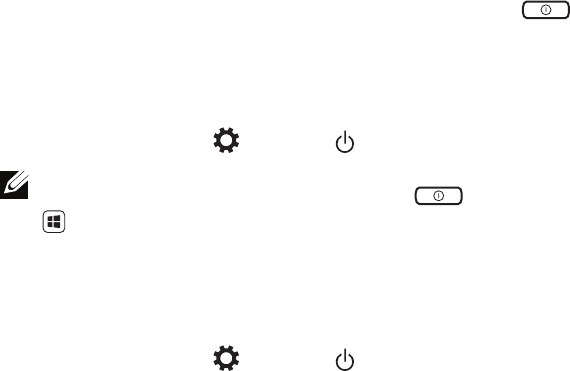
28 │ Using Your Computer
Turning O the Screen
Using the power button:•
Press and release the Power and Sleep/Wake button to turn
o the screen.
Using Charms:•
Swipe from the right edge of the display to access Charms.1
Touch 2 Settings → Power → Sleep to turn o the screen.
NOTE: If your computer is in a sleep state (computer is on, but screen is
o), press the Power and Sleep/Wake button or Windows button
once to turn on the screen.
Turning O Your Computer
Swipe from the right edge of the display to access Charms.1
Touch 2 Settings → Power → Shut down to turn o the
computer.

Using Your Computer │ 2 9
Managing Computer Settings
Refreshing your computer
Refreshing your computer restores Windows to the original factory
settings without deleting any of your personal files, installed
applications, or personalization settings.
CAUTION: Refreshing your computer removes all third-party applications.
Swipe from the right edge of the display to access Charms.1
Touch 2 Settings → Change PC settings→ General→ Refresh
your PC without aecting your files.
Touch 3 Get started.
Read the instructions on the screen then touch 4 Next.
Resetting your computer
Resetting your computer returns the system software to original
factory settings.
CAUTION: Resetting your computer erases all data from your computer,
including your account configuration, music, pictures, files, and so on.
Ensure that you back up all the required data before you proceed.
Swipe from the right edge of the display to access Charms.1
Touch 2 Settings → Change PC settings→ General→ Remove
everything and reinstall Windows.
Touch 3 Get started.
Read the instructions on the screen then touch 4 Next.

30 │ Using Your Computer
Using advanced startup
Use advanced startup if you have problems starting up your computer
or if you want to change the computer’s startup settings, such as
allowing your computer to start up from a USB device or an optical
media.
Swipe from the right edge of the display to access Charms.1
Touch 2 Settings → Change PC settings→ General→ Advanced
startup→ Restart now.
Touch the 3 Troubleshoot option to configure various startup
settings.
Hotkeys
You can access various menus on your computer using the following
hotkeys:
Menu Key combination
Boot menu Press and release both the volume up and
power buttons.
BIOS / System setup menu Press and release both the volume down
and power buttons.
ePSA menu Press and hold down the volume up and
power buttons for 3 seconds then release
both buttons.
LCD BIST menu Press and hold down the volume down and
power buttons for 3 seconds then release
both buttons.
Menu descriptions:
Boot menu• — Allows the user a method to stop the normal start-
up of the computer and bring up a special menu to run ePSA or
boot from an alternate source other than the normal boot from
the system hard drive.
BIOS / System setup menu• — A tool that halts the normal boot
process and allows the user to enter a BIOS setup mode to review
more advanced system information and perform some advanced
system settings.

Synchronizing Your Computer │ 3 1
ePSA menu• — Dell’s Enhanced Pre-Boot System Assessment.
ePSA provides valuable configuration and diagnostic information
and helps assure correct system operation.
LCD BIST menu• — A diagnostic tool which utilizes Built In Self-
Test capability to help users trouble shoot a no video scenario by
running video test outside the normal path.
NOTE: For more information on the tools available to keep your
computer running properly, see dell.com/support.
Synchronizing Your Computer
Using a Microsoft account
You can sync user settings of your computer using a Microsoft
account. When you sign in with your Microsoft account on your
computer, you can automatically synchronize your settings, including
internet browser history, application settings, and personal files and so
on, with other Windows 8 computers.
Swipe from the right edge of the display to access Charms, then 1
click Settings → Change PC Settings→ Users→ Switch to a
Microsoft account to switch a local account to your Microsoft
account.
Sync your settings 2 option is added to PC Settings.
Click 3 Settings → Change PC Settings→ Sync your settings to
configure synchronization options.
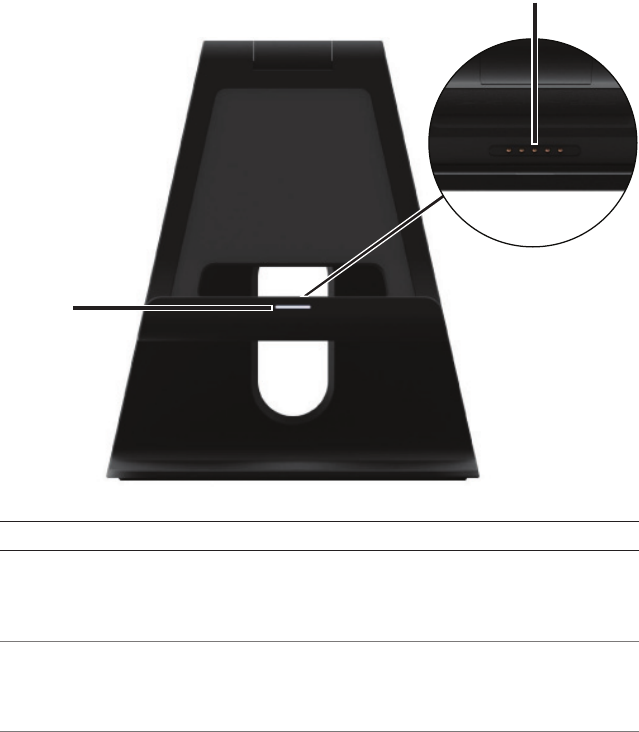
32 │ Powered Stand (optional)
Powered Stand (optional)
Features
2
1
Feature Functionality
Docking status light1 Turns on when your computer is
successfully docked (if the power
adapter is attached to the powered
stand).
Docking connector2 Connects the computer to the
docking port to provide power to
your computer and charge the
battery

Powered Stand (optional) │ 3 3
1
2
3
Feature Functionality
Powered stand hinge1 Allows you to adjust the angle of your
computer between 10 degrees and
70 degrees.
Power-adapter port2 Connect the power adapter to
provide power to the computer, and
charge the battery.
Adapter cable clip3 Holds the adapter cable in place.
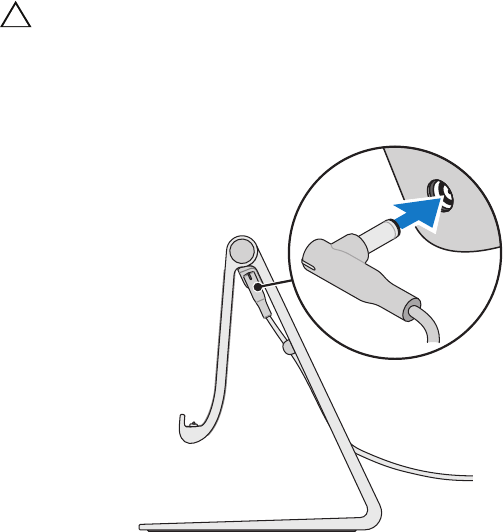
34 │ Powered Stand (optional)
Using the Powered Stand
Connect the Power Adapter to the Powered Stand
CAUTION: Use only the supplied power adapter and power cable. Using
unauthorized power adapters or power cables may cause severe damage
to your computer and powered stand.
Connect the power adapter to the power-adapter port on your 1
powered stand.
Connect the power adapter to an electrical outlet.2

Powered Stand (optional) │ 3 5
You can check the powered stand’s status from:
The light located at the front of the powered stand:•
LED behavior Description
Solid white color on Computer is docked in the powered
stand
O Computer is not docked in the
powered stand, or the power adapter
is not connected to the stand.
For more information on checking the battery status, see battery
charge indicator status table.
NOTE: If the LED is o and the computer is placed on the powered stand
with power, it may not be properly docked. Realign the computer on the
powered stand until the LED lights up.
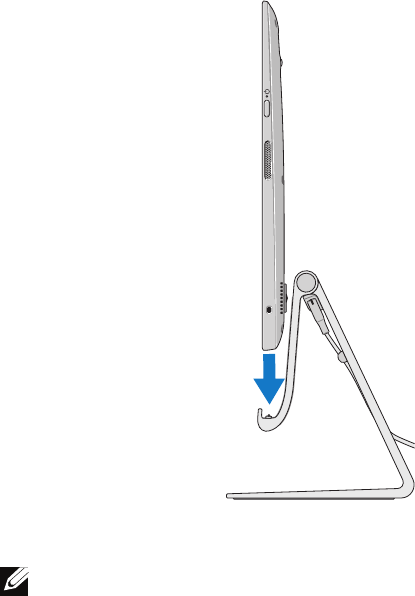
36 │ Powered Stand (optional)
Dock Your Computer on the Powered Stand
Align the docking port on your computer to the docking 1
connector on the powered stand.
Place your computer onto the powered stand.2
NOTE: The docking status light turns on when your computer is correctly
seated on the powered stand and the powered stand is properly
connected to a power source.
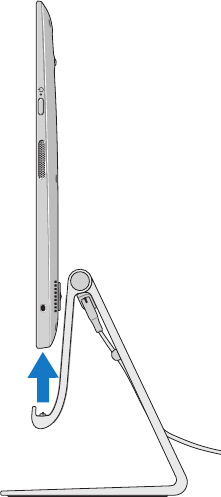
Powered Stand (optional) │ 3 7
Undocking Your Computer
Lift the computer from the powered stand.

38 │ Cleaning Your Computer
Cleaning Your Computer
CAUTION: Disconnect all cables from your computer before cleaning it.
Clean your computer with a soft cloth dampened with water. Do not use
liquid or aerosol cleaners, that may contain flammable substances.
Turn o your computer. For more information on turning o your 1
computer, see Turning O Your Computer.
Moisten a soft, lint-free cloth with either water or a display cleaner, 2
and wipe the surface of the computer until it is clean. Do not allow
water from the cloth to seep into the computer ports.
NOTE: Do not spray cleaning solution directly onto the display. Only use
products specifically designed for cleaning displays, and follow the
instructions that are included with the product.

Troubleshooting │ 39
Troubleshooting
Battery Problems
Problems Possible causes Possible solution
Battery does not charge Your computer is not •
properly plugged into
a power source.
You are using an •
incorrect power
adapter/cable.
The power outlet is •
not be working.
The power adapter/•
cable is too loosely
connected.
Use the supplied 1
power adapter and
power cable.
Unplug the power 2
adapter from the wall
and verify that the
outlet is functioning.
Check all cable 3
connections and plug
back into the wall,
then back into the
computer.
Check all connectors 4
to ensure proper
connectivity.
Verify that the power 5
adapter’s white LED is
on. If it is not, unplug
and re-plug the power
adapter and/or try
another outlet that is
known to work. If the
LED still does not turn
on, try replacing the
power adapter
The computer
temperature is lower
than 0 °C or higher than
35 °C.
Charge the battery in an
ambient temperature
between 0 °C and 35 °C.
The battery or power
adapter is damaged.
Contact technical
support or the
manufacturer to replace
the damaged parts.

40 │ Troubleshooting
System problem
Problems Possible causes Possible solution
Computer does not turn
on
The battery is
completely discharged.
Connect your computer
to a power source using
the power adapter.
Your computer could be
in an unresponsive or
locked state.
Press and hold the
power button for 11
seconds to perform a
hard shut down, then
press the power button
to turn the computer
back on.
Your computer may be
in shipping mode.
Computers shipped
from the factory will be
set in shipping mode.
To get out of this mode,
the user needs to plug in
the power adapter and
press the power button
to turn on the computer.
After the initial power
up, the computer
behaves as normal. This
is to avoid the computer
from being accidentally
turned on during
shipping and draining
the battery.

Troubleshooting │ 41
Computer is not
responding or behaving
unexpectedly
Your computer could
be in a hung or locked
state.
Reboot the computer. 1
See Turning O
Your Computer and
Turning On Your
Computer.
Refresh your 2
computer. See
Refreshing your
computer.
Reset your computer. 3
See Resetting your
computer.
Contact Dell’s support 4
service. Go to dell.
com/support or
dell.com/ContactDell.
Software or feature is
not working as expected
The application or
feature could be in a
hung state.
Software updates may
have been downloaded
in the background.
Restart your computer.
Swipe from the right
edge of the display to
access Charms and
touch Settings →
Power → Restart to
restart the computer.
Touchscreen problem
Problems Possible causes Possible solution
Touchscreen responds
slowly or improperly
Your computer display
may be dirty, or you may
need to adjust display
settings
Turn o your •
computer screen
to avoid accidental
touches, then gently
wipe the display with
a clean dry cloth.
Adjust display settings •
in Windows Desktop,
Control Panel→
Appearance and
Personalization→
Display.

42 │ Troubleshooting
Network problem
Problems Possible causes Possible solution
No wireless connection Your computer is not
able to properly access
a wireless signal.
Check if the wireless 1
radio is on. See
Enabling/Disabling
Wi-Fi.
Move closer to the 2
wireless access point.
Reset the wireless 3
router if using a
private network.
Open the browser 4
to view the landing
page if using a public
network, and follow
the instructions given
by the public network.
Try another wireless 5
connection.
Slow Internet
connections
The signal strength is
not strong enough.
Move your computer 1
to a dierent location
for better signal
reception.
Contact your Internet 2
Service Provider.
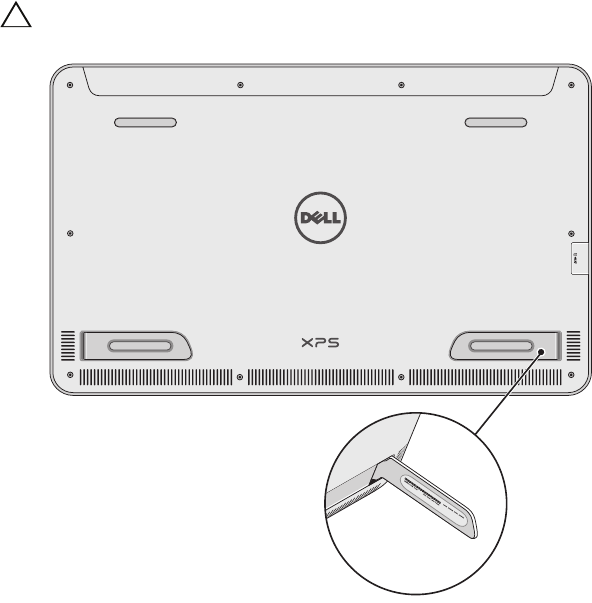
Locating Your Service Tag and Express Service Code │ 4 3
Locating Your Service Tag and
Express Service Code
You need your computer’s Service Tag/Express Service Code when
you contact Dell regarding your computer. The Express Service Code
helps the automated telephone support system redirect your call to the
appropriate support department.
The Service Tag and Express Service Code for your computer are
located on a label at the back of your computer.
CAUTION: Lay your computer face down before you look for Service Tag
and Express Service Code.

44 │ Specifications
Specifications
Physical dimensions
Height 283.70 mm (11.17 inches)
Width 463.60 mm (18.25 inches)
Depth 17.70 mm (0.70 inch)
Weight 2.20 kg (4.85 lb)
Hardware
Processor 3rd Generation Intel Core i3/i5/i7 ULT
Pentium Dual Core
Chipset Intel Panther Point HM77
Graphics Intel HD 4000 for Core I processors
Intel HD for Pentium Dual Core
processors
Internal Memory (RAM) 4 GB or 8 GB
DDR3L 1600 MHz
Internal Storage 2.5 inch HDD (SATA3) or
SSD (mSATA)
Speaker Power 2 watts
Camera HD 720 p (1280 x 720)

Specifications │ 45
Touchscreen display
Type 18.4” Full HD with multi-point
capacitive touch
Maximum resolution 1920 × 1080
Aspect ratio 16:9
Brightness 350 nits
Viewing angle 89 degrees
Contrast ratio 1000:1
Color depth 262.144 bits
Ports and connectors
Audio 1 3.5mm audio jack/port
SD card 1 SD card slot
Dock 1 docking port
USB 2 USB 3.0 ports
1 internal USB 2.0 port for wireless
keyboard and mouse receiver
Power Adapter
Input voltage 90 -240 VAC
Input current (maximum) 1.6 A
Input frequency 50-60 Hz
Output power 65 W
Output current 3.34 A (maximum)
Rated output voltage 19.5 VDC
Temperature range:
Operating 0 °C to 40 °C (32 °F to 104 °F)
Storage -40 °C to 70 °C (-40 °F to 158 °F)

46 │ Specifications
Environmental requirements
Temperature range:
Operating 0 °C to 35 °C (32 °F to 95 °F)
Non-Operating -40 °C to 65 °C (-40 °F to 149 °F)
Relative humidity (maximum):
Operating 10% to 90% (noncondensing)
Non-Operating 5% to 95% (noncondensing)
Maximum Vibration (measured using a random vibration spectrum
that simulates user environment):
Operating 0.66 GRMS
Non-Operating 1.30 GRMS
Maximum Shock
Operating 140 G
Non-Operating 163 G
Altitude (maximum, unpressurized):
Operating -15.2 m to 3048 m (-50 ft to
10,000 ft)
Non-Operating -15.2 m to 10,668 m (-50 ft to
35,000 ft)